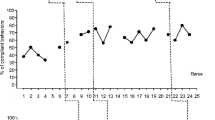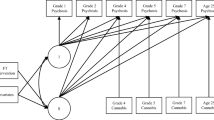Abstract
This paper describes the 2-year post-treatment follow-up of preschool children identified as having high levels of disruptive behavior at kindergarten entry. They were assigned to four treatment conditions: A no-treatment group, parent-training only, treatment classroom only, and the combination of parent training with the treatment classroom. Interventions lasted the entire kindergarten academic year. Initial post-treatment results reported previously indicated no effects for the parent-training program but some efficacy for the classroom intervention program. For this report, the disruptive behavior (DB) children were subdivided into those who did (n = 74) and did not (n = 77) receive the treatment classroom. Two-year post-treatment follow-up results indicated no differences between the classroom treated and untreated DB groups. These groups also failed to differ in the percentage of children using available treatments across the follow-up period. The DB children in both groups had significantly more symptoms of ADHD and ODD than a community control group (N = 47) at follow-up. They also received higher ratings of externalizing problems on the parent Child Behavior Checklist, more severe ratings of behavior problems at home, and ratings of more pervasive behavior problems at school, and had poorer academic skills. Results suggested that early intervention classrooms for DB children may not produce enduring effects once treatment is withdrawn, and that better approaches are needed for identifying those DB children at greatest risk for later maladjustment.
Similar content being viewed by others
REFERENCES
Abidin, R. (1986). Parenting Stress Index-Revised. Charlottesville, VA: Pediatric Psychology Press.
Achenbach, T. M. (1991). Manual for the Child Behavior Checklist and Child Behavior Profile. Burlington, VT: Thomas Achenbach.
Achenbach, T. M. (1991). Manual for the Teacher's Report Form and Teacher Version of the Child Behavior Profile. Burlington, VT: Thomas Achenbach.
Adams, G. L. (1984). Normative Adaptive Behavior Checklist. San Antonio, TX: The Psychological Corporation.
American Psychiatric Association (1994). Diagnostic and statistical manual for mental disorders (4th Ed.). Washington, DC: Author.
Arnold, L. E., Abikoff, H. B., Cantwell, D. P., Connors, C. K., Elliott, G., Greenhill, L. L., Hechtman, L., Hinshaw, S. P., Hoza, B., Jensen, P. S., Kraemer, H. C., March, J. S., Newcorn, J. H., Pelham, W. E., Richters, J. E., Schiller, E., Severe, J. B., Swanson, J. M., Vereen, D., & Wells, K. C. (1997). National Institute of Mental Health collaborative multimodal treatment study of children with ADHD (the MTA). Archives of General Psychiatry, 54, 865–870.
August, G. J., Realmuto, G. M., MacDonald, A. W., Nugent, S. M., & Crosby, R. (1996). Prevalence of ADHD and comorbid disorders among elementary school children screened for disruptive behavior. Journal of Abnormal Child Psychology, 24, 571–596.
August, G. J., Realmuto, G., Crosby, R., & MacDonald, A. (1995). Community-based multiple-gate screening of children at-risk for conduct disorder. Journal of Abnormal Child Psychology, 23, 521–544.
Barkley, R. A. (1987/1997). Defiant Children: A clinicians manual for assessment and parent training. New York: Guilford.
Barkley, R. A. (1990). Attention deficit hyperactivity disorder: A handbook for diagnosis and treatment. New York: Guilford Press.
Barkley, R. A., DuPaul, G. J., & McMurray, M. B. (1990). A comprehensive evaluation of attention deficit disorder with and without hyperactivity. Journal of Consulting and Clinical Psychology, 58, 775–789.
Barkley, R. A., Fischer, M., Edelbrock, C. S., & Smallish, L. (1991). The adolescent outcome of hyperactive children diagnosed by research criteria, III: Mother-child interactions, parenting stress, and maternal psychopathology. Journal of Abnormal Child Psychology, 20, 180–195.
Barkley, R. A., Shelton, T., Crosswait, C., Moorehouse, M., Fletcher, K., Barrett, S., Jenkins, L., & Metevia, L. (in press). Multimethod psycho-educational intervention for preschool children with disruptive behavior: Preliminary results at post-treatment. Journal of Child Psychology and Psychiatry.
Biederman, J., Faraone, S. V., Millberger, S., Curtis, S., Chen, L., Marrs, A., Ouellette, C., Moore, P., & Spencer, T. (1996). Predictors of persistence and remission of ADHD into adolescence: Results from a four-year prospective follow-up study. Journal of the American Academy of Child and Adolescent, 35, 343–351.
Bierman, K. L., Miller, C. L., & Stabb, S. D. (1987). Improving the social behavior and peer acceptance of rejected boys: Effects of social skills training with instructions and prohibitions. Journal of Consulting and Clinical Psychology, 55, 194–200.
Braswell, L., August, G. J., Bloomquist, M. L., Realmuto, G. M., Skare, S. S., & Crosby, R. D. (1997). School-based secondary prevention for children with disruptive behavior: Initial outcomes. Journal of Abnormal Child Psychology, 25, 197–208.
Campbell, S. B. (1987). Parent-referred problem three-year-olds: Developmental changes in symptoms. Journal of Child Psychology and Psychiatry, 28, 835–845.
Campbell, S. B. (1990). Behavior problems in preschool children. New York: Guilford.
Coie, J. D., Underwood, M., & Lochman, J. E. (1991). Programmatic intervention with aggressive children in the school setting. In D. J. Pepler & K. H. Rubin (Eds.), Development and treatment of childhood aggression. Hillsdale, NJ: Erlbaum.
Cunningham, C. E. (1997). Readiness for change and parent training. The ADHD Report, 5, 1–3.
Cunningham, C. E., Bremer, R., & Boyle, M. (1995). Large group community-based parenting programs for families of preschoolers at risk for disruptive behavior disorders: Utilization, cost effectiveness, and outcome. Journal of Child Psychology and Psychiatry, 36, 1141–1159.
Cunningham, C. E., & Cunningham, L. (1998). Student mediated conflict resolution programs. In R. A. Barkley (Ed.), Attention deficit hyperactivity disorder: A handbook for diagnosis and treatment (2nd ed., pp. 491–509). New York: Guilford.
Deater-Deckard, K., Dodge, K. A., Bates, J. E., & Pettit, G. S. (1998). Multiple risk factors in the development of externalizing behavior problems: Group and individual differences. Development and Psychopathology, 10, 469–494.
Durlak, J. A. (1991). Effectiveness of cognitive-behavior therapy for mal-adjusting children: A meta-analysis. Psychological Bulletin, 110, 204–214.
Forehand, R., & McMahon, R. (1981). The noncompliant child. New York: Guilford.
Goyette, C. H., Conners, C. K., & Ulrich, R. F. (1978). Normative data on Revised Conners Parent and Teacher Rating Scales. Journal of Abnormal Child Psychology, 6, 221–236.
Gordon, M. (1983). The Gordon Diagnostic System. DeWitt, NY: Gordon Systems.
Gresham, F., & Elliott, S. (1990). Social Skills Rating System. Circle Pines, MN: American Guidance Service.
Greene, R. W., Biederman, J., Faraone, S. V., Sienna, M., & Garcia-Jetton, J. (1997). Adolescent outcome of boys with attention-deficit/hyperactivity disorder and social disability: Results from a 4-year longitudinal follow-up study. Journal of Consulting and Clinical Psychology, 65, 758–767.
Heller, T. L., Baker, B. L., Henker, B., & Hinshaw, S. P. (1996). Externalizing behavior and cognitive functioning from preschool to first grade: Stability and predictors. Journal of Clinical Child Psychology, 25, 376–387.
Hinshaw, S. P. (1987). On the distinction between attentional deficits/hyperactivity and conduct problems/aggression in child psychopathology. Psychological Bulletin, 101, 443–447.
Johnson, D. L. (1988). Primary prevention of behavior problems in young children: The Houston Parent-Child Development Center. In E. L. Cowen, R. P. Lorion, & J. Ramos-McKay (Eds.), Fourteen ounces of prevention: A handbook for practitioners (pp. 44–52).Washington, DC: American Psychological Association.
Kazdin, A. E. (1987). Treatment of antisocial behavior in children: Current status and future directions. Psychological Bulletin, 102, 187–203.
Kazdin, A. E., Siegel, T. C., & Bass, D. (1992). Cognitive problem-solving skills training and parent management training in the treatment of antisocial behavior in children. Journal of Consulting and Clinical Psychology, 60, 733–747.
Kellam, S. G., Rebok, G. W., Ialongo, N., & Mayer, L. S. (1994). The course and malleability of aggressive behavior from early first grade into middle school: Results of a developmental epidemiologically-based preventive trial. Journal of Child Psychology and Psychiatry, 35, 259–281.
Kendall, P. C., & Wilcox, L. E. (1979). Self-control in children: Development of a rating scale. Journal of Consulting and Clinical Psychology, 47, 1020–1029.
Kingston, L., & Prior, M. (1995). The development of patterns of stable, transient, and school-age onset aggressive behavior in young children. Journal of the American Academy of Child and Adolescent Psychiatry, 34, 348–358.
Ladd, G. W. (1985). Documenting the effects of social skill training with children: Process and outcome assessment. In B. H. Schneider, K. H. Rubin, & H. J. E. Ledingham (Eds.), Children's peer relations: Issues in assessment and intervention (pp. 243–269). New York: Springer-Verlag.
Lahey, B. B., Applegate, B., McBurnett, K., Biederman, J., Greenhill, L., Hynd, G. W., Barkley, R. A., Newcorn, J., Jensen, P., Richters, J., Garfinkel, B., Kerdyk, L., Frick, P. J., Ollendick, T., Perez, D., Hart, E. L., Waldman, I., & Shaffer, D. (1994). DSM-IV field trials for attention deficit/hyperactivity disorder in children and adolesents. American Journal of Psychiatry, 151, 1673-1685.
Lally, R. J., Mangione, P. L., & Honig, A. S. (1988). The Syracuse University Family Development Research Program: Long-range impact on an early intervention with low-income children and their families. In D. Powell (Ed.), Parent education as early childhood intervention: Emerging directions in theory, research, and practice (pp. 79–104). Norwood, NJ: Ablex.
Lochman, J. E. and the Conduct Problems Prevention Research Group (1995). Screening of child behavior problems for prevention programs at school entry. Journal of Consulting and Clinical Psychology, 63, 549–559.
Loeber, R. (1990). Development and risk factors of juvenile antisocial behavior and delinquency. Clinical Psychology Review, 10, 1–42.
Loeber, R., Dishion, T. J., & Patterson, G. R. (1984). Multiple gating: A multistage assessment procedure for identifying youths at risk for delinquency. Journal of Research on Crime and Delinquency, 21, 7–32.
McGee, R., Partridge, F., Williams, S., & Silva, P. A. (1991). A twelve-year follow-up of preschool hyperactive children. Journal of the American Academy of Child and Adolescent Psychiatry, 30, 224–232.
Offord, D. R., & Bennett, K. J. (1994). Conduct disorder: Long-term outcomes and intervention effectiveness. Journal of the American Academy of Child and Adolescent Psychiatry, 33, 1069–1078.
Patterson, G. R., Dishion, T., & Reid, J. (1992). Antisocial boys. Eugene, OR: Castalia.
Pfiffner, L., & Barkley, R. A. (1990). Educational management. In R. A. Barkley (Ed.), Attention deficit hyperactivity disorder: A handbook for diagnosis and treatment. New York: Guilford.
Pope, A.W., & Bierman, K. L. (1999). Predicting adolescent peer problems and antisocial activities: The relative roles of aggression and dysregulation. Developmental Psychology, 35, 335–346.
Roizen, N. J., Blondis, T. A., Irwin, M., & Stein, M. (1994). Adaptive functioning in children with attention-deficit hyperactivity disorder. Archives of Pediatric and Adolescent Medicine, 148, 1137–1142.
Shelton, T. L., Barkley, R. A., Crosswait, C., Moorehouse, M., Fletcher, K., Barrett, S., Jenkins, L., & Metevia, L. (1998). Psychiatric and psychological morbidity as a function of adaptive disability in preschool children with aggressive and hyperactive-impulsive-inattentive behavior. Journal of Abnormal Child Psychology, 26, 475–494.
Stein, M. A., Szumowski, E., Blondis, T. A., & Roizen, N. J. (1995). Adaptive skills dysfunction in ADD and ADHD children. Journal of Child Psychology and Psychiatry, 36, 663–670.
Stormont-Spurgin, M., & Zentall, S. S. (1995). Contributing factors in the manifestation of aggression in preschoolers with hyperactivity. Journal of Child Psychology and Psychiatry, 36, 491–509.
The MTA Cooperative Group. 14-month randomized clinical trial of treatment strategies for attention deficit hyperactivity disorder. Archives of General Psychiatry.
Tremblay, R. E., Pagani-Kurtz, L., Masse, L. C., Vitaro, F., & Pihl, R. O. (1995). A bimodal preventive intervention for disruptive kindergarten boys: Its impact through mid-adolescence. Journal of Consulting and Clinical Psychology, 63, 560–568.
Tremblay, R. E., Pihl, R. O., Vitaro, F., & Dobkin P. L. (1994). Predicting early onset of male antisocial behavior from preschool behavior. Archives of General Psychiatry, 51, 732–739.
Webster-Stratton, C. (1998). Preventing conduct problems in Head Start children: Strengthening parenting competencies. Journal of Consulting and Clinical Psychology, 66, 715–730.
Webster-Stratton, C., & Spitzer, A. (1996). Parenting a young child with conduct problems. In T. H. Ollendick & R. J. Prinz (Eds.), Advances in clinical child psychology (Vol. 18, pp. 1–62). New York: Plenum.
Woodcock & Johnson (1984). Woodcock-Johnson Psychoeducational Test Battery. Circle Pines, MN: American Guidance Service.
Zigler, E., Taussig, C., & Black, K. (1992). Early childhood intervention: A promising preventative for juvenile delinquency. American Psychologist, 47, 997–1006.
Author information
Authors and Affiliations
Rights and permissions
About this article
Cite this article
Shelton, T.L., Barkley, R.A., Crosswait, C. et al. Multimethod Psychoeducational Intervention for Preschool Children with Disruptive Behavior: Two-Year Post-Treatment Follow-up. J Abnorm Child Psychol 28, 253–266 (2000). https://doi.org/10.1023/A:1005144304071
Issue Date:
DOI: https://doi.org/10.1023/A:1005144304071




